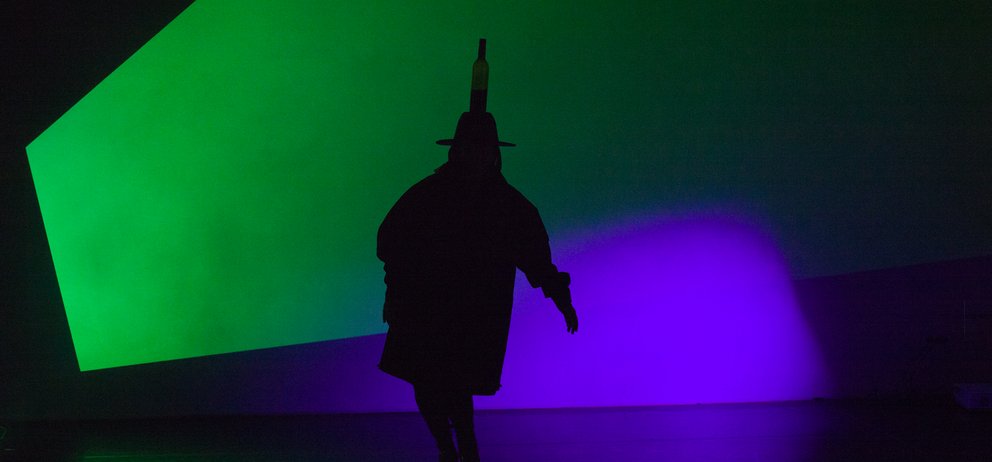Interview with Ariel Efraim Ashbel
Fiddler! A Musical
Ten years ago, Ariel Efraim Ashbel and friends presented their first German-produced piece “All white people look the same to me” at HAU3. Now the group is closing the anniversary year with their biggest show to date: “Fiddler! A Musical” is a musical extravaganza exploring the traditions of 20th-century Jewish performative crafts. In an interview with Romm Lewkowicz, Ariel Ashbel talks about the genesis of the piece, grief and unconditional compassion.
How did the idea for “Fiddler! A Musical” come about?
It started as a joke. We were writing a funding application, and we thought “Fiddler on the Roof” was funny because most of our shows have titles of existing pieces. And I've been increasingly incorporating Jewish thinking and culture into my work. So, it started as a joke but got serious when, for the 10th anniversary of Ariel Efraim Ashbel and friends, we had the opportunity to combine two strands of our work which did not intertwine so far: stage shows and spectacles, on the one hand, which were more abstract content-wise, and salons and rituals, which relate to the Jewish calendar and traditions, on the other. A musical was an opportunity to combine the two under one umbrella.
Once you decide on the title, what does the work process look like?
In this case, we started with watching the movie, “Fiddler on the Roof” (1971), and Ethan Braun (the show’s composer and musical director) and I studied the film and abstracted it. We deconstructed and distilled the dramaturgical structure that underlies the narrative content. That naked structure then became the base to build new content, through a mix of improvising and a patchwork of references to performative crafts of the Jewish diaspora, from Russia through Germany and Central Europe to the United States. Before the rehearsals we had a seminar with all of the participants where we introduced the most important references, research questions and started exploring everyone’s associations.
You’re approaching the musical as both an experimental tradition and a Jewish tradition. How do you see the musical in relation to both experimental theater and the diasporic Jewish experience?
It’s actually the perfect intersection of these two trajectories. Jews were traditionally ostracized from the mainstream cultural establishment. Eastern European Jews, when they arrived in Berlin at the turn of the century, were frowned upon even by assimilated Jews in the big theater houses. So without access to institutions, the musical, being a hybrid of forms, allowed for unorthodox mixes, something more haphazard, more improvised, and that was very Jewish at that moment. Being culturally marginalized, Shtetl and Yiddish speaking Jews had to invent and experiment with different performative forms. That’s how vaudeville, stand-up comedy, and nonsense, these new, different, and weird forms became integrated into Jewish culture. The musical has a strong emphasis on entertaining and the immediate response of the audience. You want to make people feel and laugh. There’s an urge for immediacy, puncturing the facade of high art. And that’s the meeting point of the Jewish and experimental trajectories.
Music, both experimental and popular, is prevalent in your work. How is “Fiddler” similar and different from past shows?
I think it’s similar in that it brings in different references. That’s a thread that runs through all the shows. What is different is that we built the whole thing on the music, it’s the main dramaturgical marker. Ethan would compose stuff, I would bring in ideas, he would add his ideas, and the performers and creative crew would add on to that. Ethan created a musical map based on the “Fiddler on the Roof” score. This piece also has a big orchestra with the Solistenensemble Kaleidoskop, so music is the heart of the show, and it is taking center stage, literally.
How did the events in Israel and Gaza affect the work process?
The war started in the middle of the rehearsal period, and it obviously changed everything. We all felt that the bigger question became, ‘What exactly are we doing now’? Should we even be doing this or cancel or postpone? And if we are doing this, what do we need, and what can we propose to the audience? Everything was uprooted, like the ground was literally pulled from under our feet. And then what started to happen, on the level of the process, was that the studio became the place where we could support each other and be together. We made the decision to not think too much about the show. We were so emotionally destroyed, and the studio became a sanctuary of support, tears, laughter, and hugs. Gradually, the content started to change, too. In earlier moments in my career, I would be excited, for example, to see very intense imagery, or play with the borderlines of acceptability and offensiveness. But I realized that I cannot do this right now, not because of an intellectual or political decision, but because of an emotional need. I literally needed to see people hugging each other, and being kind to each other, and holding each other in different ways. As soon as we realized we wanted to go on with the show, we started thinking about how it could be a container for our grief and allow the people who come to see it to be part of that, too. Beyond pure entertainment, my wish, and I know it sounds very pompous, is to offer a kind of a healing ritual.
